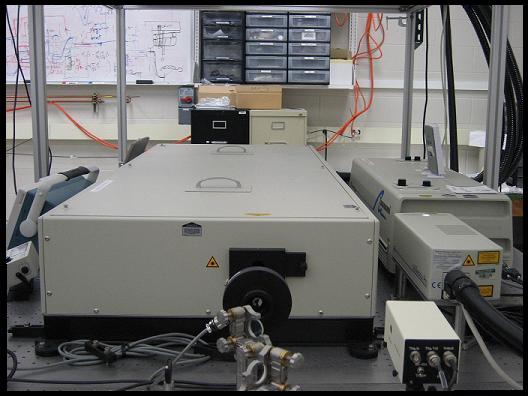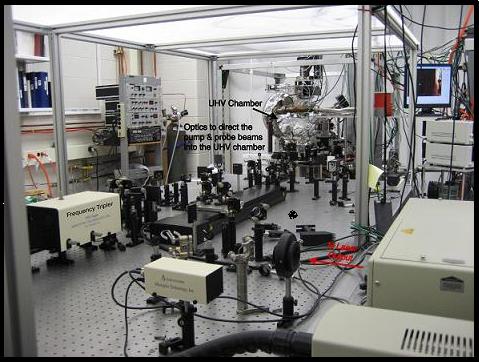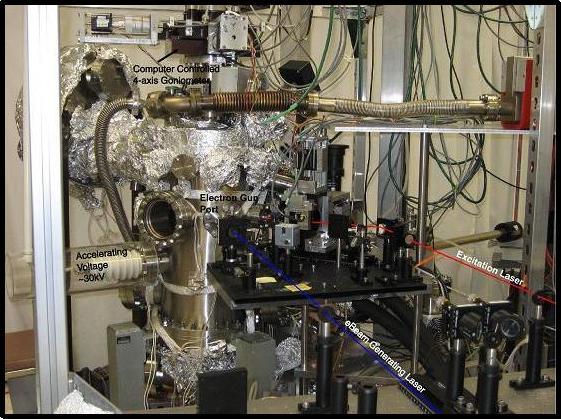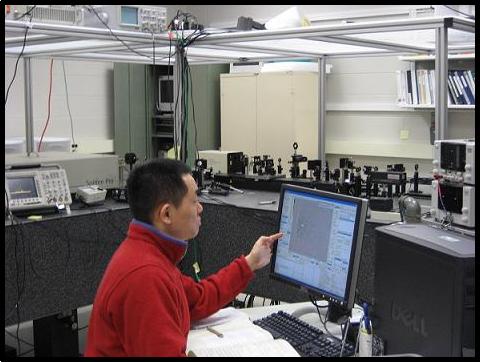|
At the heart of the entire experimental
setup is the Femtosecond(fs) LASER system. It is a mode-locked Ti:Sapphire
Laser
capable of generating extremely intense laser pulses at 800nm, ~45fs,
2.5W and 1kHz repetition rate. Thus each Laser pulse carries along with
it a peak power of almost
55GW - strong enough to cut through Steel!
This intense laser beam or
'primary' beam enters the Frequency Tripler where it undergoes frequency
upconversion, first to 400nm and then subsequently to 266nm. The
frequency doubling is achieved via a non-linear optical process inside a
Lanthanum TriBorate or 'LBO' crystal housed inside the Tripler. Due
to the non-Linear nature of the process, the efficiency of generating
frequency unconverted Laser photons increases dramatically with the
Laser intensity, which is one of the reasons for the intense primary
beam.
The output of the Tripler
has 3 separate beam lines - 800, 400 and 266nm. These beams are directed
towards the Ultra High Vacuum (UHV) chamber, using a combination of
dichroic mirrors, beam splitters, lenses and irises placed on the optics
bench. At any given time, only one of these three beams is chosen as the
excitation beam. This allows us to control the wavelength at which the
sample is excited.
Simultaneously, a part of
the 266nm beam at the Tripler output is split and directed, via
optics, towards the electron gun cathode. There, the beam impinges
on a thin silver film to generate photoelectrons via the Photoelectric
effect. This electron pulse is then accelerated to 30kV and focused
using a magnetic lens onto the sample surface. The Electron gun was
built at the Physics Machine Shop and is
designed so as to minimize the cathode-to-sample distance. This is
because the longer the electrons travel, their inherent coulombic
repulsion serves to broaden the pulse temporally, thus diminishing the
temporal resolution possible in the experiment. Our current gun has a
cathode-to-sample distance of about 5cm.
The actual experiment
occurs inside the UHV Chamber, which is maintained at extremely
low pressures of less than a few nanoTorrs. Such high vacuum is
necessary to ensure that the sample is maintained and the experiment
performed under an ultra-clean environment, particularly for nanoscale
material investigations. When the Laser excites the Nanomaterials, they
are kicked into an excited state, where they are highly reactive and
have a high propensity to react with any contaminants which might be
inside the chamber, thus destroying the original sample. Thus, an
ultra-clean environment is essential to preserve the sample integrity.
These UHV conditions are achieved using a cascade of
vacuum pumps (dry rotary, Turbomolecular and Ion Pumps), each designed to achieve
lower pressures than the
previous.
The sample is placed at the center
of this UHV chamber. The excitation laser (shown in red in the figure) enters
the chamber at 45 degrees relative to the electron beam. The electron
beam is then allowed to diffract off from the sample. Each electron
packet, being only a few 100 fs long, only see the instantaneous excited
state of the system. The diffraction pattern thus corresponds to an
excited state structure of the sample. This diffraction patttern is
captured on the imaging system consisting of an Intensifier CCD Camera.
The intensifier serves to magnify the otherwise weak diffraction signal.
The arrival of the electron beam
at the sample, relative to excitation laser, is controlled using a transnational
stage. Translating the stage forward, in effect, decreases the path
length of the excitation laser. Hence, the excitation laser arrives much
earlier than before - or equivalently, the electron beam is delayed relative
to the excitation laser. Thus, by delaying the electron pulse more and
more relative to the excitation, one can monitor the evolution of the
diffraction pattern in time following the excitation, which in turn,
provides insight into the structural evolution and bonding dynamics. One
can literally see how the atoms are moving!
The entire setup is
computer controlled. Once the laser and the electron beam have been
optimized, the data acquisition is automatic, controlled by the
computer. It is typical for experiments to run unaided overnight,
requiring only regular checks at periodic intervals to ensure smooth
progress of the experiment. i.e. under normal circumstances, sleeping
bags aren't required in the lab, except under rare (yet to occur)
critical situations!
Currently, all our
experiments are performed at room temperature. However, we are in the
final stages of testing our design of a new, Cryogenic Sample Holder
capable of reaching 40K or lower with an atmosphere-to-UHV sample
transfer capability. Once incorporated into the chamber, it will allow
us to perform experiments at very low temperatures and also insert /
remove samples in and out of the chamber without venting it to
atmosphere, thus minimizing its exposure to atmospheric contaminants.
In addition, we are
currently building a more powerful electron gun at the Physics Machine
Shop, which will be able to focus the electron beam to less than 1mm
in size onthe sample surface. The reduced size will enable us to perform
Time Resolved Local Probe Experiments
and in conjunction with the cryogenic sample holder, will help us
achieve significantly higher signal-to-noise ratio in our experiments,
thus improving our spatial resolution.
The Lab is also in possession of a
Cambridge Instruments Scanning Electron Microscope which will be made
operational in the near future.
Departmental / External Resources
Keck Microfabricatrion Laboratory
Physics
Machine Shop
|

The Femtosecond LASER System

The Optics Bench

The Ultra High Vacuum (UHV) Chamber

Computerized Data Acquisition
|